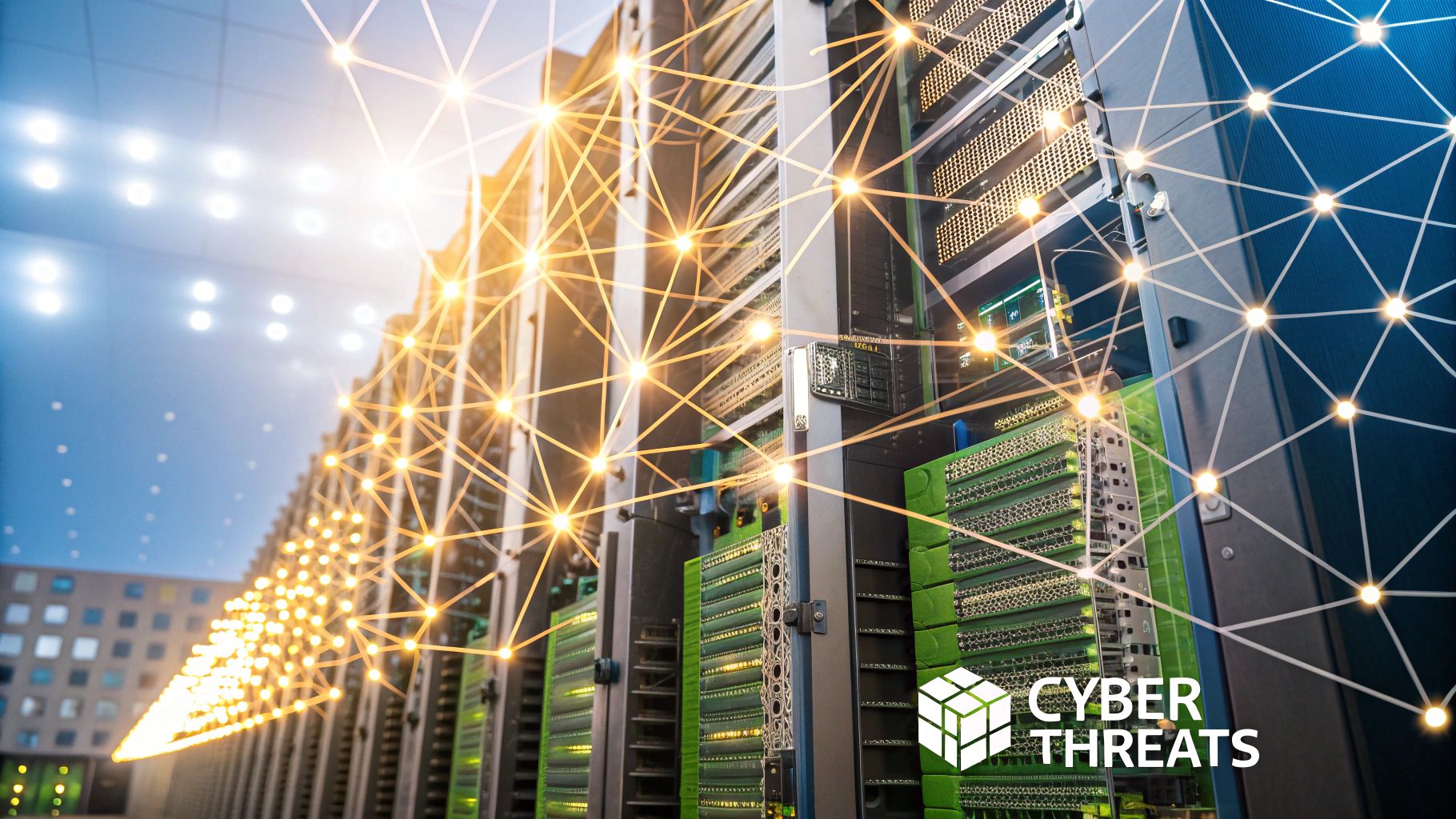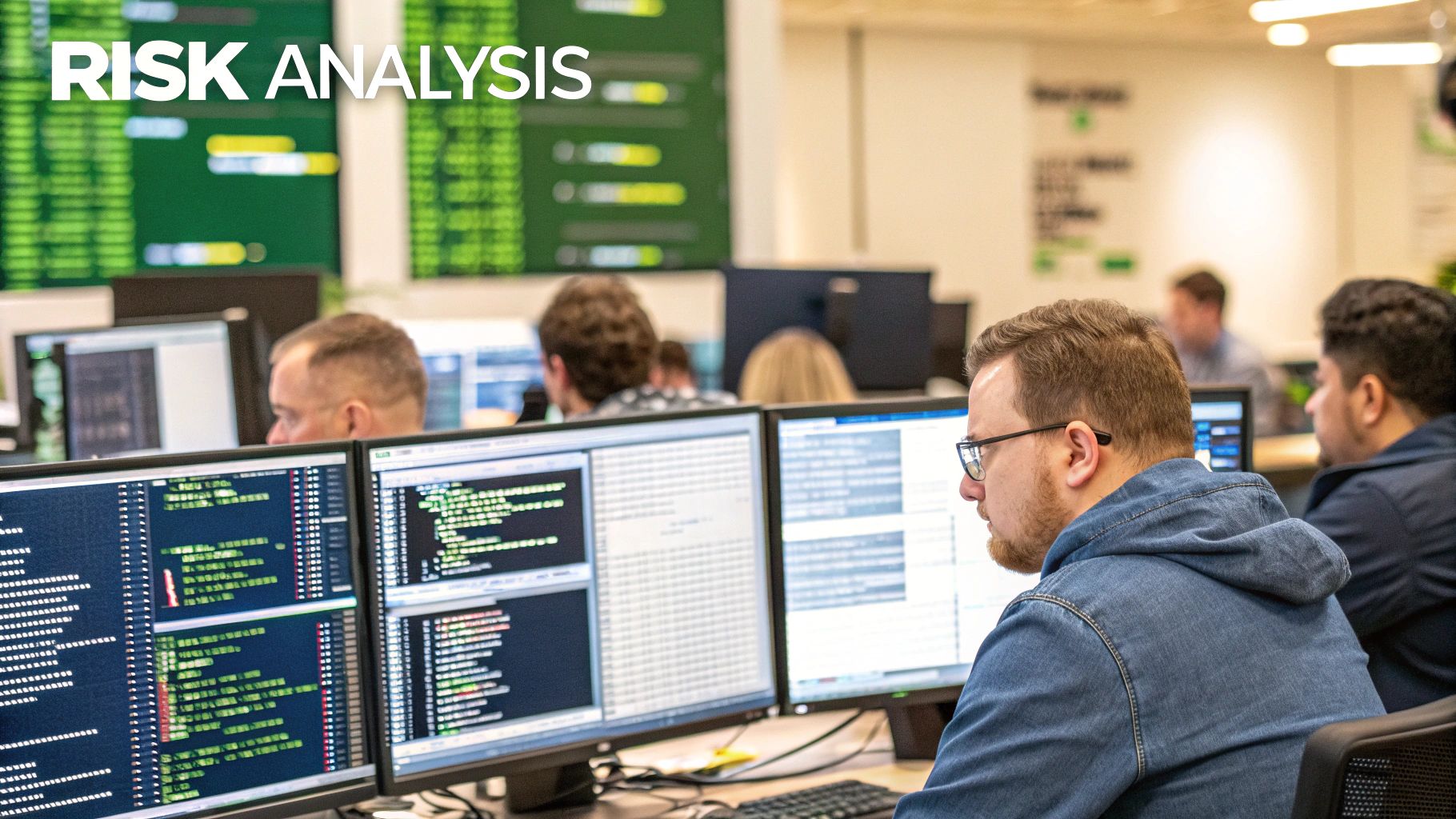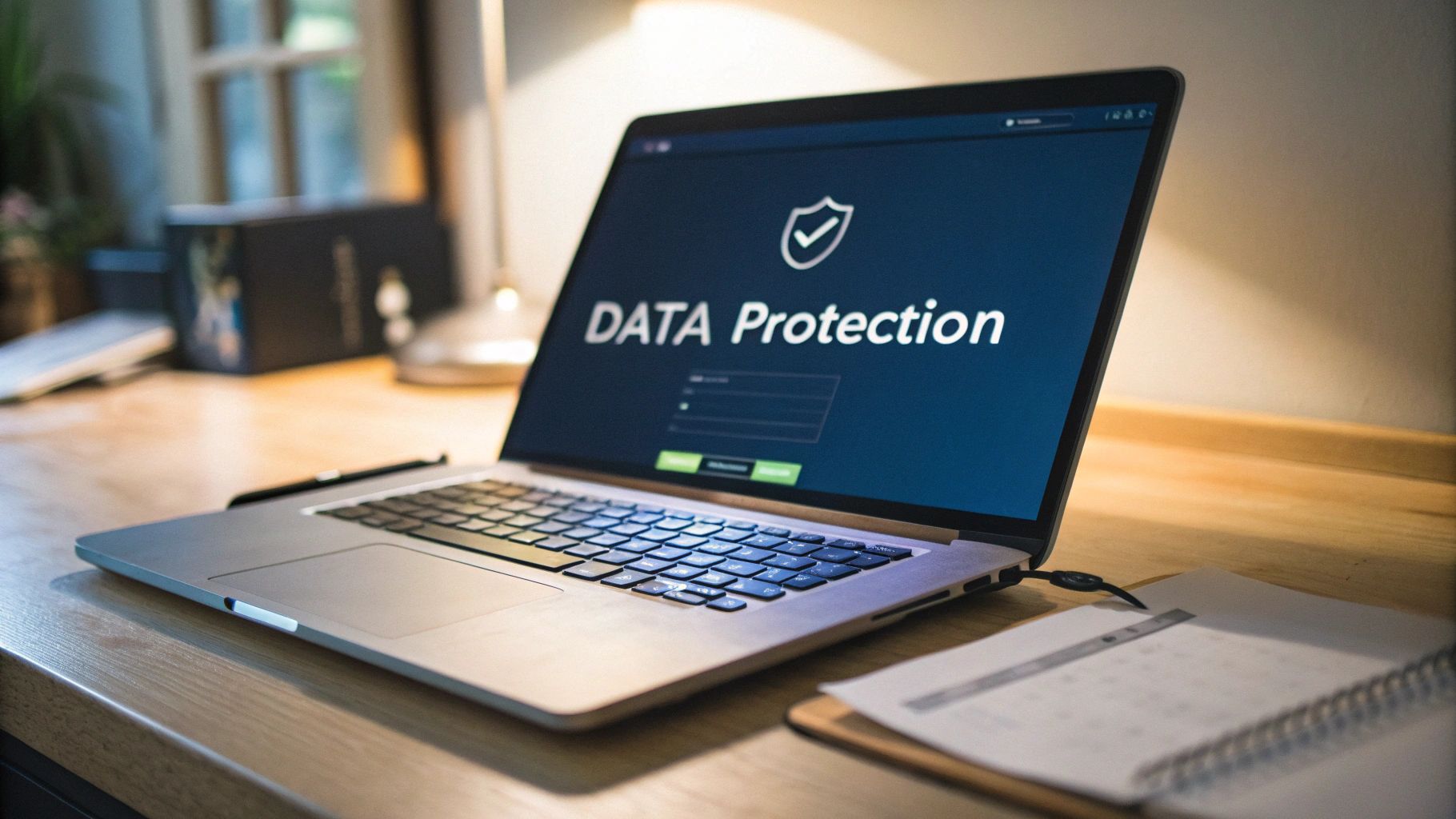The Complete Guide to Cybersecurity Risk Management: Proven Strategies for Modern Organizations
Understanding the Modern Cybersecurity Landscape

Cyber threats are becoming more complex and aggressive each day. As organizations adopt new technologies and ways of working, they face an expanding set of security risks that require smarter defenses. Understanding these modern threats is essential for building effective protection.
The Evolving Threat Landscape
Remote work and cloud computing have dramatically changed how organizations operate – and how they need to think about security. When employees access company systems from home or coffee shops, it creates new weak points that attackers can exploit. Poorly configured cloud services can accidentally expose sensitive data. These changes mean security teams must constantly adapt their approach to stay ahead of threats.
The numbers tell a concerning story about cloud security in particular. 75% more cloud breaches occurred in 2023 compared to the previous year. 23% of these incidents stemmed from simple misconfigurations, while 27% of companies experienced security incidents in their public cloud systems. Phishing remains the top method criminals use to steal cloud credentials, according to research from SentinelOne.
The Psychology of Cyberattacks
Today's cyber criminals don't just exploit technical flaws – they manipulate human psychology. Through carefully crafted phishing emails and social engineering, they trick people into sharing passwords or granting system access. Ransomware attacks lock up critical data and demand payment, putting psychological pressure on victims. This human element means security awareness is just as important as technical controls.
Adapting Security Postures
Smart organizations are moving beyond basic security checklists to take a risk-based approach. This means carefully assessing which assets need the most protection and where the biggest threats lie. With limited resources, companies must focus their efforts on the most critical risks first. Regular testing and updates help ensure defenses stay current as threats change.
Key Takeaways
- New work models create new risks: Remote work and cloud systems need specialized security measures
- Human behavior matters: Technical controls must be combined with security awareness
- Focus on critical risks: Identify and protect your most important assets first
Staying secure requires ongoing attention and quick adaptation as threats evolve. By understanding today's risks and taking a systematic approach to security, organizations can better protect their people, systems and data. This knowledge provides the foundation for building stronger defenses.
Building a Comprehensive Risk Management Framework
A strong cybersecurity program starts with a well-designed risk management framework – not just reacting to threats, but proactively identifying and addressing them. This systematic approach helps organizations protect their assets more effectively by focusing resources on the most critical risks before incidents occur.
Identifying and Assessing Risks
The foundation of effective risk management is a thorough understanding of what needs protecting. Just as a doctor needs to understand a patient's health before making a diagnosis, security teams must first map out their organization's key systems, data, and infrastructure. This reveals potential weak points that attackers could exploit, from outdated software and weak passwords to gaps in employee security training.
The next step is evaluating each risk through both qualitative and quantitative analysis. Qualitative assessment draws on expert judgment to evaluate scenarios, while quantitative methods estimate potential financial losses. Together, these approaches paint a clear picture of the threat landscape and guide informed decisions.
Prioritizing and Mitigating Risks
Since organizations can't eliminate every risk, they must focus on what matters most. By ranking risks based on potential business impact, security teams can direct their limited resources to address the most serious threats first. For example, preventing a major data breach would typically take priority over minor system disruptions.
With priorities set, organizations can implement targeted controls to reduce key risks. These might include technical safeguards like firewalls and monitoring systems, as well as administrative measures such as security policies and staff training. The key is finding the right balance between protection and business needs – security shouldn't create unnecessary obstacles to getting work done.
Building a Risk Register and Aligning with Business Goals
At the center of this framework is the risk register – a living document that tracks identified risks, assessments, and mitigation plans. This central record helps teams monitor progress, maintain accountability, and keep stakeholders informed. It serves as both a playbook and a progress report for the organization's security efforts.
Making risk management work requires close partnership between security and business teams. Rather than treating security as just a cost center, successful programs show how protecting assets enables business growth and innovation. When expanding to cloud services, for instance, the risk framework should evolve to address new cloud-specific challenges while supporting the organization's strategic goals.
Practical Approaches and Frameworks
While building a risk management program may seem daunting, organizations don't have to start from scratch. Industry standards like the NIST Cybersecurity Framework and ISO 27001 provide tested blueprints and best practices that work for companies of all sizes. These frameworks create a common language and shared expectations that help security teams collaborate effectively.
Implementing Risk Mitigation Strategies That Work
Creating a risk management framework is just the beginning. The real challenge comes from putting cybersecurity risk management into everyday practice through concrete actions that actually improve security. Let's look at the key elements that make risk mitigation work.
Building Effective Security Architectures
Think of security architecture like building a house – you need a solid foundation first. This means carefully designing your networks with proper segmentation, setting up strong firewalls, and choosing the right security tools. For instance, keeping sensitive data on isolated network segments means that even if attackers breach one area, they can't access everything. Multiple security layers working together create better protection.
Implementing Practical Access Controls
Good access control comes down to a simple principle: give people exactly what they need to do their jobs, nothing more. Tools like multi-factor authentication add extra security by requiring more than just a password to gain access. Regular reviews ensure that as people's roles change, their access permissions stay up to date. This careful approach to access rights helps limit potential damage from compromised accounts.
Developing Incident Response Plans
Security incidents can happen despite our best efforts. That's why having a clear incident response plan is essential. This plan should spell out exactly who does what when problems occur. Regular practice runs help teams stay ready to act quickly and work together effectively when real incidents happen. The goal is to contain problems fast and get systems back to normal.
Technical Controls and ROI
Some security tools deliver much more value than others. Intrusion prevention systems and data loss prevention (DLP) tools often prove their worth by stopping expensive security incidents before they happen. The numbers show how important these choices are – experts predict global cybersecurity spending will reach $1.75 trillion between 2021-2025. In 2023, companies worldwide spent about $188.3 billion on security and risk management as more businesses adopted remote work and cloud services. You can learn more about these spending trends here.
Taking real action on security makes the difference between having a plan and having actual protection. Organizations that focus on putting good security practices to work see measurable improvements in their ability to handle threats.
Mastering Risk Transfer and Insurance Strategies
Even with strong security measures in place, no organization is immune to cyber incidents. That's why transferring risk is essential for protecting your business financially. Cyber insurance plays a key role in this strategy by helping cover costs when incidents occur.
Evaluating Cyber Insurance Options
When choosing cyber insurance, you need to carefully review what different policies actually cover. Key factors to consider include:
- Coverage Scope: Does it protect against data breaches, ransomware, business disruption?
- Policy Limits: What are the maximum payouts for different types of incidents?
- Deductibles and Premiums: How much will you pay upfront and per incident?
- Exclusions: Which specific scenarios aren't covered?
- Support Services: Does it include incident response teams, legal help, PR support?
Negotiating Better Coverage Terms
Insurance policies aren't set in stone – you can often negotiate better terms. Having strong security practices in place improves your position. For example, using multi-factor authentication and regular security training shows insurers you're serious about prevention. This can help you get better coverage and possibly lower premiums.
Recent data shows why this matters. According to the World Economic Forum, 48% of small organizations don't have cyber insurance, compared to just 16% of larger ones. Good coverage provides critical financial protection and helps organizations recover faster after incidents. You can find more detailed statistics here.
Building a Comprehensive Risk Transfer Strategy
While cyber insurance is important, it's just one piece of the risk management puzzle. Other key elements include:
- Service Level Agreements (SLAs): Clear terms defining vendor responsibilities and liability
- Contractual Risk Transfer: Contract clauses that share incident costs with other parties
- Risk Retention: Setting aside funds to cover certain types of losses directly
Demonstrating Security Maturity
Insurance companies want to see that you take security seriously. Regular vulnerability testing, documented incident response plans, and strong security controls don't just protect your organization – they make you more appealing to insurers. This can lead to better coverage options and lower costs. When combined thoughtfully, these different approaches create a solid foundation for handling today's cyber risks.
Measuring Security Performance That Matters
Getting security right requires more than just putting controls in place – you need to track their effectiveness. Instead of focusing only on basic vulnerability counts, smart security teams use Key Performance Indicators (KPIs) that show how well their security program reduces real risks to the business.
Identifying KPIs That Predict Success
The most valuable security metrics help predict future issues and demonstrate clear value to leadership. Focus on KPIs that reveal how quickly and effectively your team handles security challenges:
- Mean Time to Detect (MTTD): How many hours or days pass before finding a security incident? Faster detection suggests better monitoring.
- Mean Time to Respond (MTTR): What's the average time to contain and resolve incidents? This shows response plan effectiveness.
- Number of High-Risk Vulnerabilities Open: Track critical issues to spotlight major risks and verify fixes are working.
- Security Training Completion Rate: Higher completion numbers indicate staff are learning key security practices.
These metrics tell a clearer story about security performance than raw incident counts.
Building Dashboards That Drive Action
Raw security data needs context to be useful. Great dashboards highlight what matters most – like your riskiest vulnerabilities based on business impact and how easy they are to exploit. Showing trends in attack patterns or open vulnerabilities helps teams grasp emerging threats. With clear visuals, teams can focus resources on their biggest risks.
Continuous Monitoring Without Overwhelm
While ongoing monitoring is crucial, drowning in alerts helps no one. Use automated tools to filter out minor issues and focus on real threats. Set smart alert thresholds so teams only get notified about significant problems. Review and update your monitoring approach regularly as threats change. This targeted strategy prevents alert fatigue while catching what matters.
Frameworks for Measuring Security ROI and Reporting
Proving security's business value can be tricky. Standards like the NIST Cybersecurity Framework and ISO 27001/27002 provide structured ways to measure and report on security. These frameworks help benchmark your program against industry standards and explain progress clearly to leadership. Regular metric reviews with executives build trust and justify continued security investments. Focus on sharing complex security data in simple terms that show how protection efforts support business goals.
Future-Proofing Your Security Strategy
Keeping your organization safe from cyber threats requires constant adaptation and forward planning. Just as attackers evolve their tactics, security teams must stay ahead by regularly evaluating their defenses and preparing for what's next. Let's explore how to build security programs that can stand the test of time.
Adapting to Emerging Threats and Technologies
The security landscape changes every day as new technologies enter the workplace. Tools like AI systems and connected IoT devices create fresh opportunities – but they also open new doors for attackers. Security teams need updated strategies to protect these expanding networks. For example, as AI-powered attacks grow more common, defenses must evolve to detect and block these sophisticated threats automatically.
Building Flexible Security Systems
Fixed, rigid security setups quickly become outdated as threats change. The key is building systems that can adapt easily when needed – like adding new security tools or changing configurations to address emerging risks. Think of it like building with modular components that you can swap in and out. This flexibility helps teams respond quickly without having to rebuild everything from scratch.
Creating Strong Security Programs That Last
The best security programs can take a punch and keep running. This means having solid plans for handling incidents, maintaining backups, and keeping the business moving during disruptions. Regular security training for employees is also crucial – they need to understand current threats and best practices. This complete approach to cybersecurity risk management helps minimize problems when incidents occur.
Key Strategies for Long-Term Security
- Use Automation Effectively: Let software handle routine security tasks so your team can focus on bigger challenges
- Stay Informed About Threats: Keep up with new vulnerabilities and attack methods to address risks early
- Build Your Security Team: Hire and keep skilled security professionals who can strengthen your defenses
- Work Together: Make sure security teams communicate well with other departments
Taking this proactive, adaptable approach helps organizations build security programs ready for tomorrow's challenges. The key is staying alert and being ready to evolve as new threats emerge.
Ready to improve your debugging and development process? Check out DebugBar for essential tools that will boost your web development workflow.


